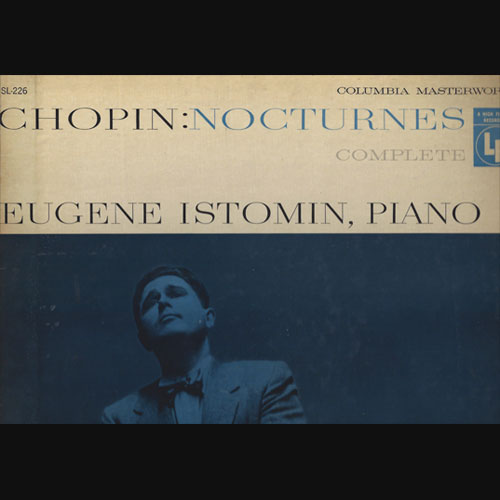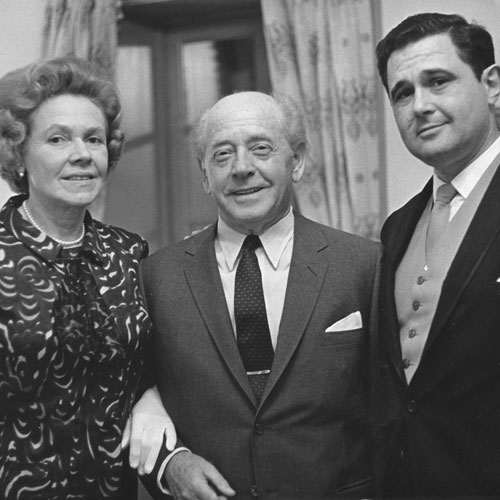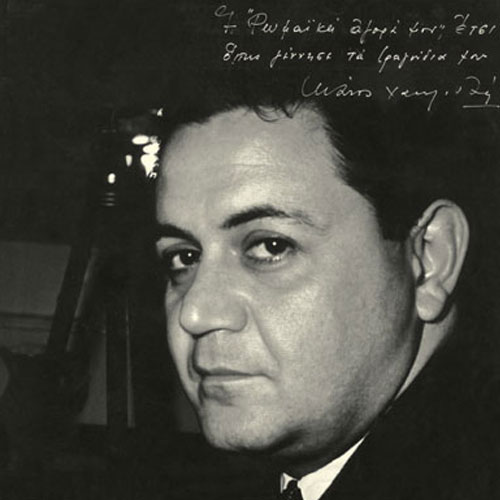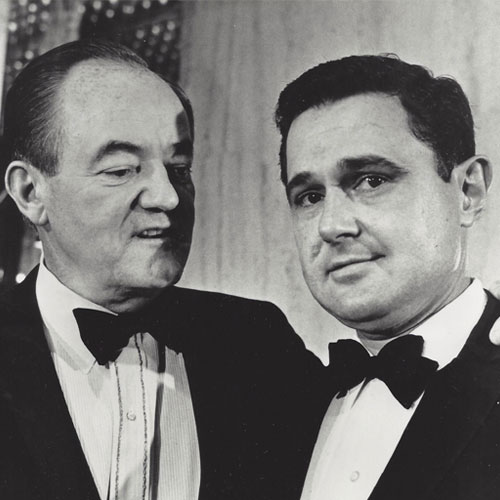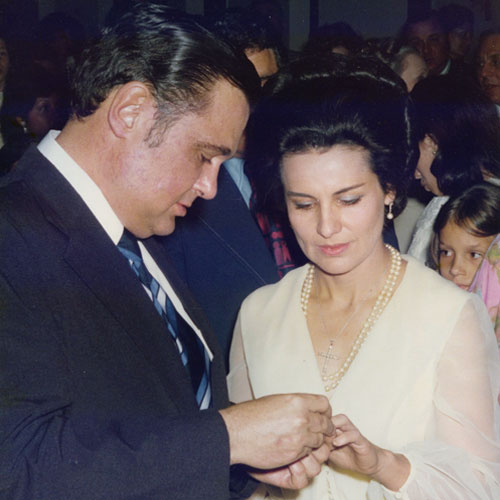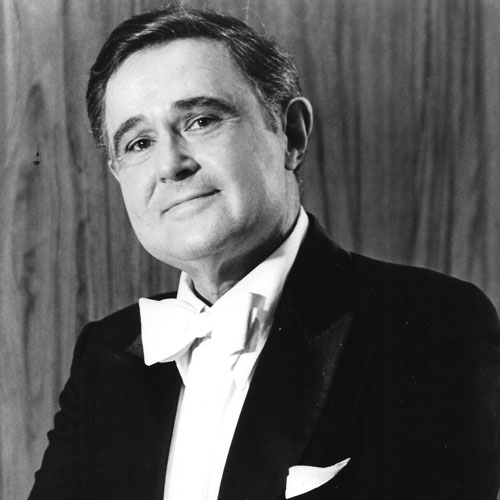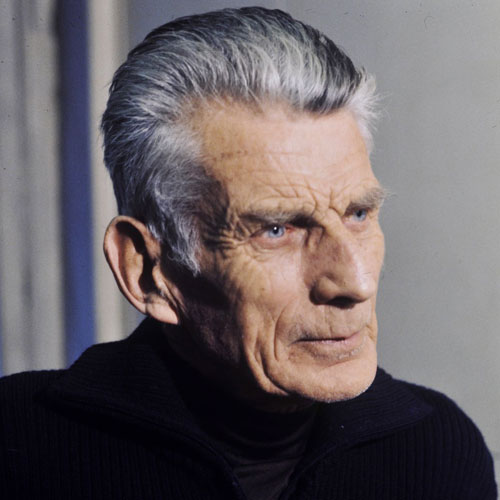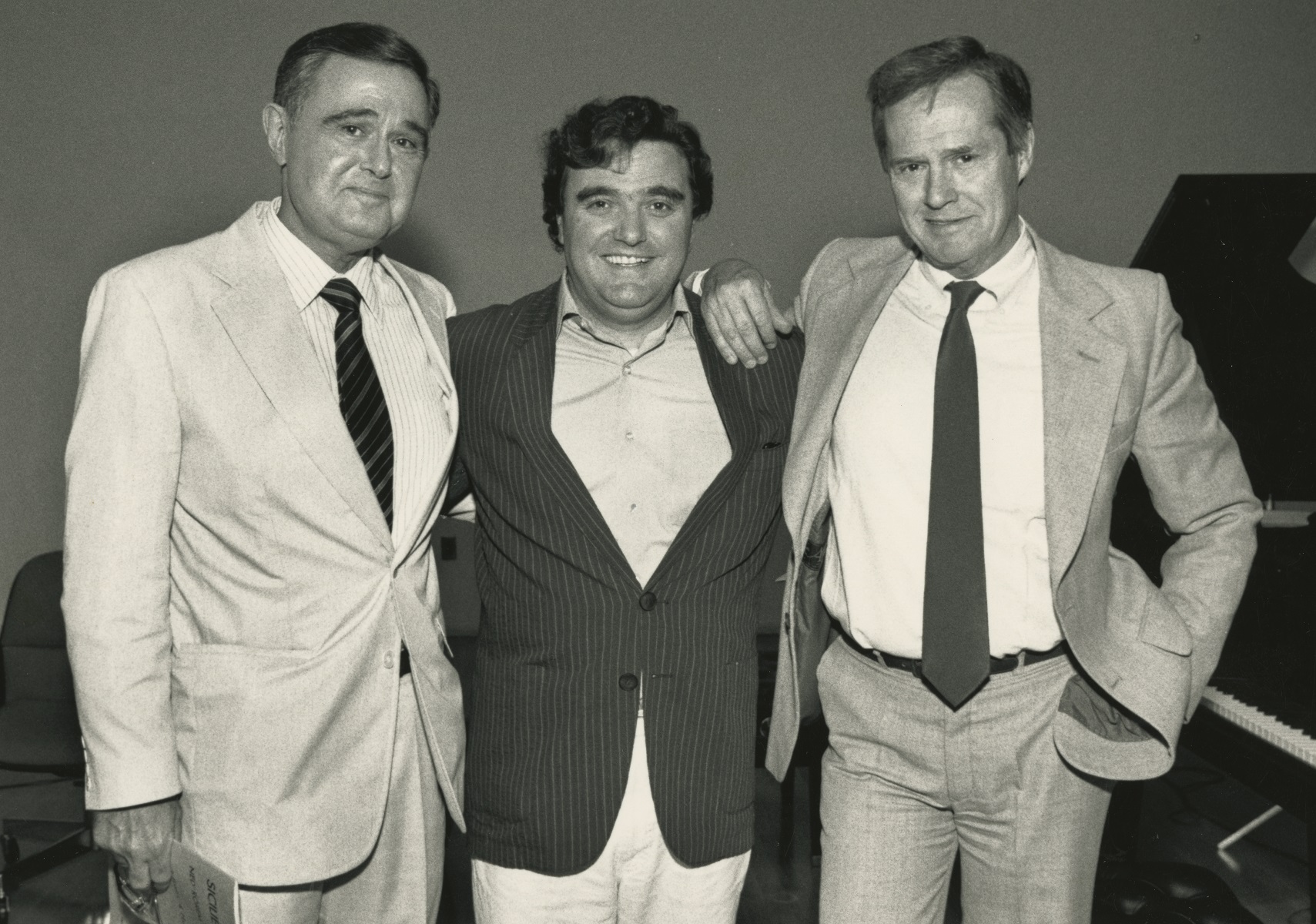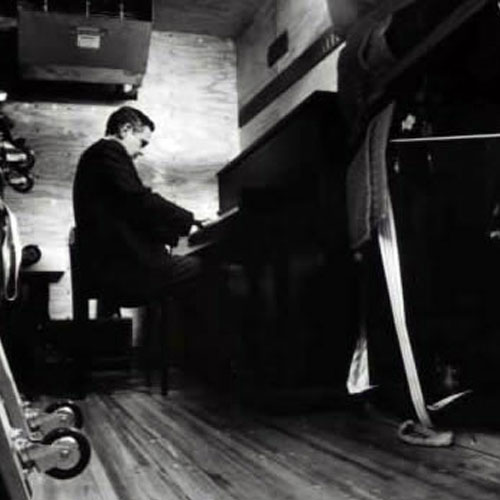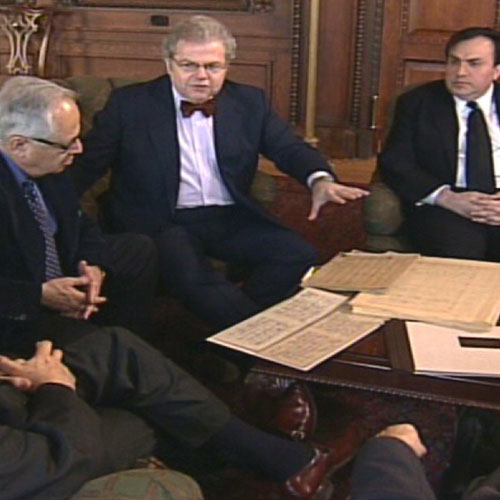1925
November 26 – Born in New York, to Russian parents who emigrated to USA after the Soviet Revolution. Eugene Istomin’s father, Yuri, belonged to the Russian nobility and fought in the Tsarist army. His mother Feera came from a Jewish family in Odessa.
Feera Chavin when she arrived in New York in 1922
1930
Since his father played the guitar badly, becomes the family pianist and accompanies his parents, who earn their living by singing and dancing in Russian cabarets. In addition to Russian songs, is immersed in operatic arias through the singing of his parents and the records of the super stars (Caruso, Schipa, Galli-Curci, Ponselle) that they collect.
Feera and Yuri Istomin in stage costumes
1932
Is introduced to Siloti, a former Liszt student and central character of the musical life of Saint Petersburg before the Revolution. Siloti agrees to oversee his musical education on the condition that his parents do not exploit him as a child prodigy. Siloti’s daughter Kyriena takes him to Rachmaninoff’s where he plays one of the little Beethoven Sonatas Op. 49 and receives encouragement from the great musician.
With Alexander Siloti in 1932
1934
Continues his training with Siloti, assisted by Kyriena, who also teaches him to write Russian, read and speak French. Is virtually a member of the Siloti family and often sleeps at their apartment, on the top floor of the Hotel Ansonia, a meeting place for all the great Russian artists, such as Stravinsky and Koussevitzky. Starts becoming a baseball fan and is invited to the All-Star Game by his uncle.
Eugene Istomin at age seven
1935
Buys his first book, “The Three Musketeers” by Alexandre Dumas, and develops a passionate love for literature. Goes to school for the first time, attending the classes at the Professional School for Children, but often playing truant, wandering the streets and parks, going to Central Park Zoo, or sneaking into the cinema.
The Three Musketeers, Ed. Grosset & Dunlap, New York, 1928
1937 – 1938
Worried that his son was spending so little time at the piano, his father decides that he should stop taking lessons with Alexandre Siloti and continue his education at Mannes School of Music. After hearing two concerts of Josef Hofmann, the young Eugene is fascinated by the great pianist and dreams of studying with him. He knocks on the door of Hofmann’s hotel room and asks to play for him. He is kindly dismissed and recommended to apply to the Curtis Institute.
Josef Hofmann circa 1940
1939 – 1943
Studies at the Curtis Institute with Serkin and his assistants (Jorge Bolet – during the first year, then Mieczyslaw Horszowski). Attends concerts of all the most important musicians performing in Philadelphia (Rachmaninoff, Rubinstein, Kreisler, Heifetz, Feuermann, Stokowski, Beecham, Bartók…). Surrounds himself with a wide circle of friends (including Leonard Bernstein and Ned Rorem) to make music, talk and have fun. Spends the rest of his free time devouring books and going to the movies.
Serkin and Istomin in the mid-1950s
1943
In October, wins in quick succession the Youth Competition organized by the Philadelphia Orchestra and the Leventritt Competition. As prizes, makes his debut with the Philadelphia Orchestra conducted by Eugene Ormandy on November 17 (Chopin, Concerto No. 2) and with the New York Philharmonic under Artur Rodzinski on November 21 (Brahms, Concerto No. 2). The New York concert is broadcast live nation-wide and immediately launches him to fame. Arthur Judson becomes his manager.
1944
Gives more than 40 concerts with Adolf Busch and his chamber orchestra, performing concertos by Mozart (K. 449, 365 and 414) and Bach (BWV 1052 and 1061). First recital in New York in April at Town Hall. Spends the summer with the Busch family and discovers the chamber music repertoire with Adolf and Hermann. Meets William Kapell and Isaac Stern and strikes up a friendship with them. In December, debut with the Chicago Symphony (Rachmaninoff, Concerto No. 3) and return with the New York Philharmonic and Rodzinski (Beethoven, Concerto No. 4).
1945
From January 8 to March 24, gives 54 concerts with Adolf Busch and his chamber orchestra, adding Mozart’s Concerto K. 271 and Chopin’s Andante Spianato et Grande Polonaise to the previous repertoire. Makes his first recording in April: Bach’s Concerto BWV 1052. Debut with the National Symphony (Chopin, Concerto No. 2) with such success that he has to play two encores. Spends the summer once again with the Busch family. Acquires his first important painting, a gouache by Picasso.
With Adolf Busch in Columbia Studio
1946
In February, gives his graduate recital at the Curtis Institute, then his first recital at Carnegie Hall, playing Brahms’ Handel Variations and Chopin’s 4 Scherzos. Returns with the New York Philharmonic and Rodzinski for Beethoven’s Emperor. Auditions for Paul Paray, who promises to invite him. Spends the summer at Martha’s Vineyard and practices Gaspard de la nuit. Paul Goodman translates for him the prose poems by Aloysius Bertrand which inspired Ravel. Develops a passion for the works of Ezra Pound. On December 6, second recital at Carnegie Hall.
1947
On January 7, Rodzinski writes to his most distinguished colleagues (Koussevitsky, Monteux, Szell, Mitropoulos and Dorati), suggesting that they invite a very talented young pianist: Eugene Istomin. Gives numerous Community Concerts all over the US. Is acclaimed at Lewisohn Stadium after playing Beethoven’s Emperor with the New York Philharmonic and gives Ravel’s Ondine as an encore. First conflict with his management. Spends a lot of time in Greenwich Village talking with avant-garde artists and left-wing activists.
Artur Rodzinski in the early 1940s
1948
Recital at Carnegie Hall on February 20, where Gaspard de la nuit is a great success. In March, first collaboration with Szell (the Chopin Second with the New York Philharmonic). From March to September takes a sabbatical in France (Paris, Nice and Cap Ferrat) and visits Florence and Rome. Adolf Busch asks him to attend his first concert in Germany since 1933. Participates in a concert dedicated to Tolstoy. Following Mrs. Leventritt’s advice, tries to heal his stage fright by psychoanalysis.
George Szell in the late 1940s
1949
Two concerts with the New York Philharmonic, in June under Reiner (Beethoven Four) and under Stokowski at Carnegie Hall (Mozart K. 271). Plays the Beethoven Fifth in Houston (Efrem Kurtz) and New Orleans (Massimo Freccia). Spends most of the summer with his friend William Kapell. On Mrs Leventritt’s initiative, meets Alexander Schneider and performs the Beethoven complete Violin Sonatas four times during the fall. First appearance with Szell in Cleveland in November (Mozart K. 271).
1950
Concerts in January with the Chicago Symphony under Ormandy and Szell, and in February with Pittsburgh under Paul Paray. First concerts in France in spring, invited by Paray. He is the youngest participant in the Prades Festival, and spends the whole summer there with Casals. In autumn, concerts in Italy, Lisbon and Switzerland, thanks to the recommendations of Casals and Serkin. First concerts with Steinberg in Buffalo in December. Records Bach’s 5th Brandenburg Concerto, Toccata BWV 914 and Trio Sonata BWV 1038.
Pablo Casals smoking at home
1951
Recital at Carnegie Hall on January 12. Tours in USA and Canada. Records the Brahms’ Handel Variations in March, his first solo recording. Participates in the Perpignan Festival in July, recording Mozart’s Concerto K. 449 under Casals as well as four Beethoven Trios and Schubert’s First with Schneider and Casals. Visits Greece in August, which appears to him as the “cradle of our civilization”. Becomes friendly with Manos Hadjidakis. Tour in Italy in the autumn, including a concert at La Scala.
Rehearsing with Casals in 1952
1952
Many invitations from major American orchestras (Pittsburgh, Boston, Montreal, Los Angeles, Philadelphia), particularly during summer festivals (Ravinia, Philadelphia, Robin Hood Dell, Hollywood Bowl, Lewisohn Stadium), joining again Paray, Szell and Steinberg, and collaborating for the first time with Kubelik and Leinsdorf. Participates in the Prades Festival in June, where he plays with Casals, Stern and Schneider and accompanies Jennie Tourel.
With Jennie Tourel in Prades
1953
Together with Madeline Foley, replaces Schneider as Artistic Director of the Prades Festival. Hires new soloists (Kapell, Grumiaux, Fuchs) and an orchestra composed mainly of outstanding American instrumentalists. Tragic death of his friend William Kapell in a plane crash. In December, impressive series of tremendous successes: Brahms’ Second in New York with Szell, Chopin’s Second in Detroit with Paray and Beethoven’s Fourth in Philadelphia with Ormandy. Records two Beethoven Trios with Fuchs and Casals.
Rehearsing with Casals in Prades
1954
Performs the Beethoven Fourth with Szell in Cleveland and Jorda in San Francisco, the Beethoven Fifth with Katims in Seattle, the Chopin Second with Ormandy in Philadelphia and Krips in Montreal, Organizes the Prades Festival, devoted to Beethoven’s chamber music with Casals, Fuchs, Goldberg, Serkin and Horszowski. The festival is a great success. It is recorded by the French Radio and broadcast all over Europe. His recital in London in October wins the Harriet Cohen Award for best recital of the year.
1955
Assumes for the last time the artistic direction of the Prades Festival, giving six concerts in ten days with Casals, Menuhin and Vegh. In August, first concerts of the Istomin-Stern-Rose Trio in Ravinia, which are well received by the audience, while the critics are more divided. Debut with the Munch and the Boston Symphony. First tours in South America and South Africa. Memorable Beethoven Fourth Concerto with Szell and the New York Philharmonic in December. On David Oppenheim’s initiative, starts an ambitious program of recordings for Columbia with the Chopin Nocturnes.
1956
Tour in Iceland. First tour in Asia (50 concerts in Singapore, Hong Kong, Japan and Manila). Concerts in England, Switzerland and Italy. Concert tour in Australia which he has to interrupt due to burnout. Organizes a series of concerts for Clara Haskil in the USA. Time Magazine devotes a portrait to him in which he is considered the equal of Rachmaninoff, Rubinstein, Horowitz and Serkin! Records the Rachmaninoff 2nd Concerto. The LP is a huge success and sells more than 200, 000 copies.
1957
Concerts with Monteux in Montreal, Mitropoulos in New York, Ormandy, Paray, Reiner, Markevitch. Short tours in Europe (England and Netherlands). Returns to Australia. Participates in the first Casals Festival in Puerto Rico. Spends the summer in Marlboro. Appears on the cover of Musical America under the title: “The World at his Fingertips”. McCormick, editor-in-chief at Double Day, proposes that he write his autobiography. Records Mozart’s Quartet K. 493 and Brahms’ Intermezzi Op. 117.
1958
In January, records Beethoven’s Emperor Concerto with Ormandy. New tour in South Africa. Concerts with Bernstein and the New York Philharmonic (Schumann Concerto) in the presence of Casals. Participates in the Casals Festival in Puerto Rico and spends most of the summer in Marlboro again. First performance with the Budapest Quartet at the Library of Congress. Many concerts with Munch in Boston and Tanglewood.
Piano duets with Charles Munch!
1959
Long tour in spring with the Royal Scottish Orchestra under Hans Swarowski (Chopin, Second Concerto). First meeting with Arnold Toynbee. Concerts with Munch, Ormandy, Hendl, and Krips. Important participation in the Casals Festival in Puerto Rico where he plays the Schumann Concerto under Schneider, trios by Mendelssohn and Brahms with Stern and Casals, and accompanies Eileen Farrell in Schubert songs. Returns to Marlboro in August. Records the Tchaikovsky First and Chopin Second with Ormandy and Philadelphia.
With Schneider and Casals
1960
Records Schumann’s Concerto under the direction of Bruno Walter in January. Conflicts with Columbia and cancellation of the other scheduled recordings. Multiple performances of Beethoven’s 4th and 5th Concertos (Philadelphia, Minnesota, Los Angeles, Houston, National Symphony…), as well as Leon Kirchner’s 1st Concerto (including three times with the San Francisco Symphony under the composer). Becomes fully committed to the presidential campaign in support of Kennedy.
With Bruno Walter in the studio
1961
Performs with at least twelve American orchestras: San Francisco, Detroit (Tornakowsky), Boston (Munch and Monteux), Philadelphia (Ormandy), National Symphony, Chicago (Reiner), Milwaukee, Seattle, Rochester, Los Angeles, Rhode Island and New England. Once again spends a part of the summer in Marlboro. Official launch of the Istomin-Stern-Rose Trio at the Israel Festival. In November and December, plays concertos and trios in London.
Rehearsing with Stern and Rose, 1961
1962
Spectacular debut of the Trio in the USA at Carnegie Hall, the Metropolitan Museum and the White House! Filled with enthusiasm after meeting Kennedy, he is willing to serve his country and be an ambassador of good will. Two concerts at Seattle’s World Fair. Soloist with the Puerto Rico Festival Orchestra at Carnegie Hall. Participates in the first Athens Festival at the Herode Atticus Theater and establishes a close relationship with Princess Irene of Greece. Plays the Brahms Second under Bernstein in the newly inaugurated Lincoln Center. Soloist in Paray’s farewell concerts in Detroit. Changes his management, leaving CAMI for Hurok.
Kennedy greets Istomin and Rose
1963
Acts as cultural ambassador of goodwill by giving concerts in Bulgaria for two weeks, in Ankara, Beirut and Tehran. Strikes up a lifetime friendship in Sofia with musicians Jerzy Semkow and Jean-Bernard Pommier and Ambassador Eugenie Anderson who later introduces him to Hubert Humphrey. From May to October, gives 80 concerts in Europe and Israel, including a series of 9 concerts with the Israel Philharmonic under the young Zubin Mehta. Takes part, alone or with Stern and Rose, in almost every major European festival (Aix, Lucerne, Edinburgh, Israel, Menton, Montreux). Shattered by Kennedy’s assassination.
1964
Tour with the Los Angeles Philharmonic in January. Recital at Carnegie Hall in February – again a tremendous reception from the audience but mixed reviews. Gives 7 concerts with the Philadelphia Orchestra and 6 with the Boston Symphony. Supports Johnson and Humphrey against Goldwater in the presidential election. Approves Humphrey’s plan to establish a National Council and Foundation for the Arts. The concerts of the Trio are sold out everywhere (five in New York, including two at Carnegie Hall). Records the Brahms Trio Op. 87, the Beethoven Triple Concerto and Schubert’s First Trio.
1965
Attends the Presidential Inauguration of Johnson. Cultural ambassador in spring, touring Russia and Romania. First concert at the Théâtre des Champs-Elysées (with the Orchestre National de France under Kletzki). Strikes up a friendship with the painter Avigdor Arikha and Samuel Beckett. Returns to Prades. At Rubinstein’s request, learns Szymanowski’s Symphonie Concertante and plays it under Skrowaczewski. Records Brahms’ Second Concerto with Ormandy. Publication of Sessions’ Third Piano Sonata dedicated to Istomin.
With Ormandy and Eugenie Anderson
1966
Eight concerts with the Philadelphia Orchestra under Ormandy and Maazel. Returns with the Cleveland Orchestra under George Szell. Summer residence in Detroit with the Trio and its “students” (Pommier, Zukerman, Harrell). Goes to Vietnam but his recital is cancelled for security reasons. Realizes the impossibility of winning this war and the duplicity of the CIA. Participates along with Vice-President Humphrey in the celebration of Casals’ 90th birthday. American tour with the Trio, recording Beethoven No. 3 and Mendelssohn No. 1.
The Trio in Central Park
1967
First tour in New Zealand. Plays with the Trio for the Montreal World Exhibition. After the coup in Greece, welcomes his friend Manos Hadjidakis to his apartment in New York. Fulfills his contract for two concerts with the Trio at the Herode Atticus Theater, but voices his disapproval and refuses to perform in Greece from then on. His support was acknowledged in 1974 by the new Greek democratic authorities. Participates again in the Israel Festival, with the Trio and as the soloist of the Israel Philharmonic (Brahms Second under Josef Krips). Ends the year in Europe (concerts in England, Switzerland and France).
Manos Hadjidakis
1968
Supports Humphrey’s candidacy for the presidential election. Takes the lead of the Arts and Letters Committee in a very conflicting atmosphere, up to the point that he is whistled at when walking onstage at the Lincoln Center. Invited to the Lucerne and Edinburgh festivals where he performs Schubert’s Trio in E-flat for the first time and meets Rostropovich. Humphrey, narrowly defeated by Nixon, says that he would have asked Istomin to be his cultural advisor. Records two Brahms Trios and the Beethoven Fourth Concerto for the 25th anniversary of his debut.
Hubert Humphrey and Eugene Istomin
1969
Tours in Asia and New Zealand. Numerous concerts with American orchestras: Boston under Leinsdorf, Philadelphia under Ormandy, Detroit under Erhling, Pittsburgh under Steinberg, Baltimore under Comissiona. A year very rich in recordings: Schubert (Trio D. 929 with Stern and Rose and Sonata D. 850); Beethoven (2 Violin Sonatas with Stern, 2 Cello Sonatas with Rose, 3 Trios); Songs by Ned Rorem with the baritone Donald Gramm.
LP cover of Schubert’s Sonata D. 850
1970
Beethoven bicentennial year. The Istomin-Stern-Rose Trio makes headlines, touring the USA and South America in spring, and Israel in summer. The Trio meets the unprecedented challenge of performing Beethoven’s complete chamber music with piano in four cycles of eight concerts in London, Paris, Switzerland and New York (Carnegie Hall). This adds up to more than 60 concerts (including the Triple Concerto under Casals). Participates in the US summer festivals: Hollywood Bowl, Saratoga, Blossom. Completes the recording of the Beethoven Trios (which receives a Grammy Award). However, in conflict with Columbia, refuses to finish the violin and cello sonatas.
1971
Reasserts his willingness to serve as a cultural ambassador, offering to go and perform in China. In January and February, recitals in Boston and Paris. The Trio performs for the inauguration of the Kennedy Center and goes on tour in Japan (Istomin also gives a recital in Tokyo). Plays Bach’s Concerto BWV 1064 at the UN when Casals is presented the Peace Medal. Death of his father on November 15 while he is on tour with the National Symphony and Dorati. Successful recital at Carnegie Hall. The New York Times publishes a portrait entitled: “Istomin: I like to be Alone”.
Eugene Istomin with his parents
1972
As Humphrey is a candidate for the Democratic primaries, provides his support but in a less committed way. Abandons all political activity after Humphrey is overtaken by McGovern. Arikha’s first exhibition in the USA. Series of televised concerts in Paris under Schneider: Mozart Concertos K. 271, 449, 365. Numerous recitals in prestigious venues (Queen Elizabeth Hall, Academy of Music in Philadelphia, Chicago Orchestra Hall, Boston, San Francisco). Summer residencies with the Detroit Symphony, the Cleveland Orchestra and the Chicago Symphony.
With Jean-Bernard Pommier in 1972
1973
First semester mainly dedicated to recitals: Fantasies by Beethoven and Mozart, two Impromptus by Schubert, Handel Variations by Brahms, Debussy’s Preludes and the 4th Ballade by Chopin. Concerts with the Chicago Symphony and Solti (Mozart K. 271). Plays the Symphonie Concertante by Szymanowski with the Cleveland Orchestra. Participates in the Israel Festival in August. Series “Stern and Friends” at Carnegie Hall in autumn. Death of Casals on October 22. Delivers Casals’ eulogy at Columbia University.
With Stern and Rose in the early 1970s
1974
In January, concert with the Trio at Carnegie Hall. Strong presence in Europe. Gives recitals in London and Paris and plays with the Radio Orchestras. Films the complete Brahms Trios for the French Television. Agrees to play in Germany (Bonn and Frankfurt) for the first time. Performs under his friend and former student Pommier. Many concerts with Skrowaczewski (Detroit and Minneapolis) and Ormandy (in Philadelphia and Washington). Tours the USA with the Trio in November. Becomes aware of his love for Marta Casals.
1975
In January takes part in a tribute to Albert Schweitzer, Casals’ close friend. Marriage to Marta in New York on February 15. Tours in Latin America and Canada. Important participation in the Puerto Rico Festival: chamber music with Stern, Rose, Zukerman, Forrester, and Emperor Concerto. New collaboration with the National Symphony and Dorati. Starts a lasting association with David Zinman. Principal guest of the Mostly Mozart Festival. Plays Mozart’s Concerto K. 467 for the first time, under Eduardo Mata. In autumn, tour in Asia.
Marta and Eugene’s wedding
1976
Numerous concerts in Europe (France, Poland, Italy, Switzerland, Portugal). Plays in Spain, finally liberated from Franco. Collaborations with Tilson Thomas and Ormandy. Divides his summer between the USA (Hollywood Bowl, Mostly Mozart, Puerto Rico) and Europe (Prades, Lucern). Organizes the Jornadas Casals in Mexico for the 100th anniversary of Casals’ birth, creating a Mexican orchestra and inviting the London Symphony. At Horowitz’s suggestion, prepares the Chopin Variations by Rachmaninoff. After returning to CAMI, changes his management again and signs with ICM.
1977
In February, tour in Italy. In March, recital at the Kennedy Center. Improvises an accompaniment for Luciano Pavarotti and Renata Scotto during a social event. First concerts under Rostropovich at the Kennedy Center and Carnegie Hall. Repeated collaborations with Jerzy Semkow (in Saint Louis and Puerto Rico) and Sergiu Comissiona (in Pittsburgh and Baltimore). In the fall, American tour with the Trio. Columbia reissues some of his LPs (Schumann, Tchaikovsky, Chopin) and proposes new recording projects, soon to be abandoned.
Marta and Eugene Istomin in 1976
1978
Death of Humphrey in January. Participates in two tribute concerts. Gives nearly 100 concerts with orchestra, with Tennstedt (Detroit Symphony, Israel Philharmonic), Dorati (National Symphony), Steinberg (Seattle), Comissiona (American Symphony), Rudel (Mostly Mozart Festival), Skrowaczewski (Minneapolis), Mehta (Los Angeles), Erhling (Detroit Symphony), Zinman (Rochester), Fleisher (Annapolis) Joo (Calgary), Eros (San Diego), Gamba (Winnipeg), etc. Returns to Germany and goes to Austria for the first time.
1979
Concerts and recitals in the USA and Europe. After the signing of the Israeli-Egyptian Peace Treaty, obtains the agreement of all authorities to give master classes and concerts in Cairo and Jerusalem. Attempts to promote exchanges between Israeli and Egyptian musicians. Tours in Germany, Austria, Spain, France and South America. Death of his mother while playing Brahms’ 2nd Concerto with the Philadelphia Orchestra. His love for books led him to become the advisor to William Jovanovich, the president of the major American publishing house HBJ. Last recording of the Trio, the Mendelssohn Second Trio.
The Istomins and the Jovanovichs
1980
Last tour of the Trio in January and February. Encourages Marta to accept the artistic direction of the Kennedy Center. Concerts with Mehta (New York Philharmonic), Dorati (Detroit Symphony and Royal Philharmonic), Rostropovich (National Symphony), Zukerman (English Chamber) and Pommier (Orchestre National de France). At Ormandy’s request, performs the Tchaikovsky Concerto again for the 90th anniversary of Carnegie Hall. Supervises the re-edition of Joseph Conrad’s complete works for HBJ.
Eugene Ormandy and Eugene Istomin
1981
Although very disappointed by Reagan’s election, accepts Rostropovich’s request to stand in for Serkin and perform for the inaugural concert on January 18. Numerous performances of Mozart’s Concerto K. 467. Inaugurates the Pau Casals Auditorium in Sant Salvador, built in front of Casals’ house, now transformed into a museum. The diplomatic tension caused by the War in Afghanistan forced him to abandon a project he had enthusiastically launched for HBJ: a series of books on the collections of the Hermitage Museum.
1982
Numerous recitals, notably in London (Queen Elizabeth Hall) and Chicago (Orchestra Hall): Bach, Toccata BWV 914; Stravinsky Sonata; Beethoven, Waldstein Sonata; Mozart, Sonata K. 576, Chopin Nocturne Op. 15 No.1 and Scherzo No. 4. Collaborations with Rostropovich (National Symphony), Bychkov (Buffalo), Mehta (Philadelphia). The Trio pays homage to Abe Fortas, former Supreme Court judge, who died in April. Moves to Watergate in Washington. Continuation of the recording of the Beethoven Violin Sonatas with Stern.
Marta and Eugene Istomin, late 1970s
1983
Performs Rachmaninoff’s Fourth Concerto for the first time in September with the National Symphony under Rostropovich and in October with the Rochester Philharmonic under Zinman. In May, last concert with Ormandy (with the Philadelphia Orchestra at Carnegie Hall). On November 22, last moving appearance of the Trio, playing the Andante of the Schubert B flat major Trio for the 20th anniversary of Kennedy’s death. Completes the recording of the Beethoven Violin Sonatas with Stern.
1984
Begins the year in Europe. Recital at the Kennedy Center in May. After a concert at the Hollywood Bowl, returns to Marlboro after an absence of 22 years. Concert at the Juilliard School in homage to Leonard Rose, who died from leukemia on November 16. Buys the Steinway CD 18 which belonged to Horowitz and on which he had recorded Rachmaninoff’s 2nd Concerto in 1956. His favorite baseball team, the Detroit Tigers, triumphs in the World Series Championship.
Istomin in Detroit Tigers uniform
1985
Member of the prestigious American delegation at the Budapest Cultural Forum in October and November. Fights against the ban in Prague of Catastrophe, a Beckett play dedicated to Václav Havel. Once again spends part of the summer in Marlboro. Accepts the direction of the Competition and Festival of the Maryland University, which he re-names in honor of William Kapell. Publication by HBJ of the facsimile edition of the Complete Works by Thomas Hardy, in 24 volumes, which he had proposed and personally supervised.
Samuel Beckett
1986
Completely changes his management in Europe, choosing Riaskoff (Benelux and Germany), Ingpen & Williams (UK), Sofia Amman (Italy) and Valmalète (France), hoping for better coherence and less transatlantic flights. Many concerts in France, Spain, Switzerland, Portugal and Israel. First edition of the Kapell Competition with a very high-level jury (Ax, Kuerti, Orozco, Pommier, Tocco, Toradze, Graffman, Aeschbacher, Lipkin, Magaloff, Browning, etc.). Commissions a piece from Dutilleux as the compulsory work for the 1988 edition.
1987
Several European tours, in Italy (February and October), Benelux (November) and England (December). New recital program with works he had never performed: Schumann, Sonata 1; Debussy, Images, Book 1. Notable performances given at Carnegie Hall and the Queen Elizabeth Hall (Rostropovich present) and subsequent recording made. Resigns from the Kapell Competition. Holidays in France (his first summer vacation since 1948).
With Pommier and Rorem in Maryland
1988
First tours across the USA with a specially equipped truck. Wants to play on his own pianos to give his best and bring music to cities now deserted by the usual concert circuits. Around 70 concerts (including some with orchestras and recitals in major cities, from January to March, then in September and October). Repeated collaborations with Rostropovich and the National Symphony (Brahms’ 2nd Concerto, Beethoven’s 4th Concerto). Concerts in France, Germany and Switzerland. Ends the year in Japan, Korea, Taiwan and Hong Kong.
1989
From January to March, new truck tour with stops in Washington and New York (recitals at the Kennedy Center and Carnegie Hall) and Rochester (Beethoven 5th Concerto with Semkow). Death of Kyriena Siloti on July 28. Recital at the Montreux Festival in September, then long tour in Italy. In October and November second concert tour with the truck. Enlarges his solo repertoire, alternating two different programs and presenting an all-Beethoven program in Italy for the first time. Undergoes surgery for tendinitis of the index finger.
1990
Truck tour from January 31 to April 17. Tour in Italy in May. Participates in the Evian Festival which celebrates Stern’s 70th birthday, playing the Archduke Trio with Stern and Rostropovich. After another truck tour in September, gives eight concerts in October with the Hallé Orchestra and Skrowaczewski (Mozart K. 467). Marta leaves the Kennedy Center. On November 5, organizes a concert at the Juilliard School in homage to Alexander and Kyriena Siloti. Tour in Australia in November. Beethoven recital at Carnegie Hall on December 5.
Rostropovich and Istomin in 1988
1991
Three truck tours in USA. Concerts with Rostropovich and the National Symphony in September (Beethoven‘s Fourth Concerto). Participates in Carnegie Hall Centennial Gala. Concert tour in France in October with a pilgrimage recital in the Théâtre de Perpignan and a Beethoven recital at the Théâtre des Champs-Elysées. Records Beethoven Sonatas 14, 21 and 31 (CD issued in 1996 by Reference Recordings).
Eugene and Marta Istomin in Connecticut
1992
New truck tours in the USA in January, February and September. Takes part in the Casals Festival in Puerto Rico and in the Evian Festival where he plays Beethoven’s Emperor Concerto with the Juilliard School Orchestra under Jean-Pierre Rampal and gives chamber music concert with Kavakos, Giuranna and Rostropovich. Tour in Switzerland, France and Italy.
Eugene Istomin portrayed by his friend Avigdor Arikha
1993
Three truck tours in January-February, April and September. Invited by the Mostly Mozart Festival (Beethoven’s Fourth Concerto under Schwarz). Tour in France and Spain in fall. His concert in homage to Casals for the 20th anniversary of his death is recorded live at the Théâtre des Champs-Elysées and issued on a private CD (Bach, Toccata BWV 914; Mozart Sonata K. 283; Casals, Prelude; Medtner, Sonata Op. 22; Beethoven, Waldstein Sonata).
On the stage of the Kennedy Center
1994
1994 : Last truck tour. In February concerts with Rostropovich at the Kennedy Center and Carnegie Hall (Beethoven’s Third Concerto). Participates in the Evian Festival, playing Beethoven’s Fourth with the Curtis Institute Orchestra and chamber music with Laredo and Rostropovich. Plays with the Philadelphia Orchestra for the Pension Fund concert. 1995 : Year divided between Europe and the USA. Records two Mozart concertos (K. 467 and K. 491) with the Seattle Symphony under Schwarz. In September, participates in a cruise on the Mediterranean dedicated to Casals.
1996
1996 : Tour in Europe in January and February (Spain, Switzerland, France) with recitals at the Palau de la Música, Tonhalle and Salle Gaveau. Performs the prelude dedicated to him by Dutilleux for the first time. Concerts in Italy and the Netherlands in autumn. 1997: Year disrupted by major hand surgery on thumb. Concerts in Italy, Poland and England. Participates in the Evian Festival, playing with Stern, Bashmet and Rostropovich. In autumn, recital at the Kennedy Center.
With Bashmet and Rostropovich
1998
1998 : European tour in autumn, including concerts with the orchestra of the San Carlo Opera orchestra in Napoli (Beethoven, Concerto No. 3), with the Orchestre National de Lille under Jean-Claude Casadesus (Mozart, Concerto No. 21) and a recital in Madrid. 1999 : Recitals in the south of USA. Plays the Beethoven Third Concerto at the Lincoln Center under Gerard Schwarz. Series of master classes at the Manhattan School of Music.
At Manhattan School of Music
2000
Participates in the Kronberg Festival (master classes and concerts). Is made Chevalier de la Légion d’Honneur at the Théâtre du Châtelet, where he made his debut in France just 50 years earlier. Jubilee in New York for his 75th birthday initiated by Rostropovich and with all his musician friends. The benefit proceeds from this night allow for the creation of two scholarships in the name of Eugene Istomin at the Manhattan School of Music. Carries out his project to pay tribute to Paul Paray by recording his Fantasy for Piano and Orchestra.
Receiving the Légion d’Honneur
2001
In June, participates in the inaugural concert of the renovated Casals Museum in Sant Salvador, with Rostropovich and Montserrat Caballé, in the presence of the King of Spain and the president of Catalonia. In December, records the first part of his Great Conversations in Music series, which is dedicated to the piano, with Emanuel Ax, Yefim Bronfman, Gary Graffman, Leon Fleisher and Charles Rosen.
Graffman, Ax and Bronfman
2002
Discovery of his liver cancer. In April records the second part of the Great Conversations in Music with the composers Ned Rorem, George Perle, Milton Babbitt, Richard Danielpour, Lowell Liebermann and Ellen Taaffe Zwilich. In November, carries out a new episode about string instruments and chamber music with Claude and Pamela Frank, Lynn Harrell, Joseph Kalichstein, Jaime Laredo, Yo-Yo Ma, Sharon Robinson and Arnold Steinhardt.
Eugene Istomin and Chutney
2003
Last part of the Great Conversations in Music with conductors James Conlon, Zubin Mehta and Mstislav Rostropovich. Dies in Washington on October 10.
Long chronologyivan2023-02-26T21:21:13+01:00




















